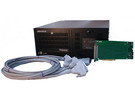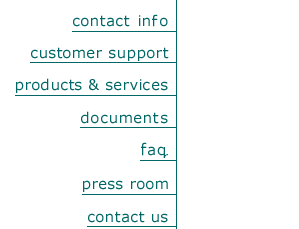
How to Access WAN Protocol Data from an IP Network
There are many ways to access WAN protocol data from an IP network. Each method has its advantages and disadvantages. These advantages and disadvantages generally reflect a tradeoff between simplicity and capability, with some methods being simpler to implement and other methods providing increased capabilities.
The following list describes some of the methods of accessing WAN data from an IP network, listed in order from the simplest to the most complex. For the purpose of these descriptions, the term "server" refers to a Freeway system (or to the machine to which the WAN protocol data lines are attached) and the term "client" refers to another machine which requires access to the WAN data (the client could also be a program running directly within a Freeway, but would still connect to the Freeway server daemon with a socket interface). The "Message Switch" is an optional software component which runs in the Freeway.

|
Call us at (U.S.): (858) 451-0865 |
The previous list includes most of the WAN access methods, but if none of those methods satisfy your needs completely, there are two more possibilities: use of a Server Resident Application (SRA) and use of Message Switch "Programmable Endpoints". An SRA can be used with any of the Freeway methods described above. Programmable Endpoints can be used with either of the Message Switch methods described above. SRA The Freeway system is programmable and includes a full set of native development tools. You can use those tools to develop an application program which runs on the Freeway itself. If that application program is written to use sockets or the DLI/TSI library to connect to a Freeway daemon (running either in the same Freeway, or another Freeway connected via an IP network), then we call it an SRA (Server Resident Application). An SRA can utilize all the features of the Freeway, just as any client application can, but because it runs in the Freeway it can perform extra work before the data leaves the Freeway; it can thus make the Freeway into a self-contained data processing system, rather than simply a data-transferring system. For example, an SRA could be written to capture data from several WAN lines and output a report (to the console, to a socket, or any to other output device) when those datastreams differ. SRAs can be as simple or as complex to write as any other Freeway client application. They can be written to use the socket-level Message Switch interface or the DLI/TSI interface, in either Normal-Mode or Raw-Mode. In fact, all of the client application programs described in the first 4 methods above can run directly on a Freeway as an SRA: the socket-level program to send and receive IP data, the socket-level program to send and receive IP data and WAN control information, the Normal-Mode client program, and the Raw-Mode client program will all run on a Freeway. Message Switch Programmable Endpoints The Message Switch software which runs on the Freeway can be configured to transfer data from a set of inputs to one or more sets of outputs. From the Message Switch's point of view, these inputs and outputs are simply "endpoints"; the Message Switch takes data from each endpoint and sends it to one or more other endpoints. These endpoints can be WAN links, UDP or TCP sockets, or other devices (hard disks files, etc.). Another type of endpoint supported by the Message Switch is called "Programmable Endpoints". Programmable Endpoints are separate programs, running on the Freeway, which have their Standard Input and Standard Output connected to the Message Switch. When the Message Switch is configured to use a Programmable Endpoint, it forks a separate process running the Programmable Endpoint program, with data pipes set up to connect that process to the Message Switch. Whenever the Message Switch sends data to that endpoint, the Programmable Endpoint process will receive it on stdin, and whenever the Programmable Endpoint process sends data to stdout, the Message Switch will be able to read it from that endpoint. Because the Programmable-Endpoint program is a simple stdin-stdout program, it can be easy to create, but because it has access to all of the features of the Freeway it can have great power. For example, a program to compress WAN-link data can be written in about 250 lines of C code, and another program to send WAN-link data to an FTP server can be written in even fewer lines. The last program described above is a good example of the power and flexibility of the Freeway when running the Message Switch with Programmable Endpoints. When configured this way, the Freeway will take all of the data on all desired WAN links and write it into a set of files on an FTP server; and it will begin doing so automatically, as soon as it is powered up, with no intervention necessary by any person or other machine. Our RecommendationsWe recommend that you use the simplest method which still provides all the capabilities you need. When choosing a WAN-access method, it is also important to remember that most of the methods described above can be used in combination with each other. Use of one method does not preclude the simultaneous use of other methods. For example, a single Freeway with several WAN lines could be running the Message Switch and also several different SRAs, and could be accessed simultaneously by different client programs, some socket-level (data-only and data-and-control) and some DLI/TSI (Normal-Mode and Raw-Mode). Back to the top-level Protogate webpage |


